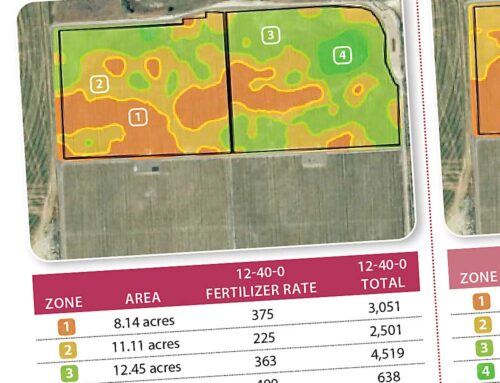
Tony Freytag, vice president of sales and marketing for Crunch Pak, speaks during the U.S. Apple Association Apple Crop Outlook and Marketing Conference in Chicago, Illinois on Aug. 23, 2013. (Richard Lehnert/Good Fruit Grower)
Fresh sliced apples have been a boon for Washington producers, providing them with an important market for small fruit. But, so far, pear growers can only look on enviously.
Fresh sliced apples is a $475-million industry nationally, and Crunch Pak, based in Cashmere, Washington, is the largest producer. Tony Freytag, senior vice president of sales and marketing, said pears were the first item the company tried slicing when it was founded 12 years ago, but has never been able to make it work well enough. At least, not yet.
Today, Crunch Pak produces about two million apple slices daily, with sales volume increasing by more than 20 percent annually for the last four years.
About 8 percent of the U.S. Gala, Pink Lady, and Granny Smith apple crops are sliced.
Crunch Pak is adding grapes and carrots to its line of health snacks, and has not given up on the idea of slicing pears, though it is fraught with challenges.
“It’s been a quest so far unattainable,” he told growers at the Washington State Horticultural Association’s annual meeting in December. “But we will keep trying to perfect it. We believe it’s what the consumer wants and will eat. It’s not something we’ve pushed to the back burner and said, ‘We’ll never do it.’”
Freytag sees it as a way to sell more pears, particularly to young people who value convenience, but the challenge is to find a way to slice a pear so the slices will be sweet and juicy, won’t turn brown, won’t curl around the edges, can be shipped across the country, and will have a reasonable shelf life once they arrive. And do that consistently.
Soft, not crisp
One of the difficulties is that a good-eating pear is soft, not crisp, like an apple. A pear with 6 to 8 pounds pressure has very good flavor but turns to mush when sliced.
An 8- to 10-pound pear has good flavor but will bruise heavily when sliced. A 12- to 14-pound pear is great for slicing but has no flavor and dries out quickly.
What seems to work best is a pear in the 10- to 12-pound range, which has good flavor, is sliceable, and will continue to mature and become slightly sweeter in the package. It would need a sugar level of at least 10° Brix.
It will take a close alliance with pear growers and packers who are willing to experiment with long-term storage and ripening and find out how long the raw pears need to be ripened to reach the desired softness for slicing.
A Bosc pear will not work for slicing because of its shape and narrow neck. Removing the seed cavity will probably break the neck off, reducing the percentage of edible pear, Freytag explained. Comice pears would be too soft. Freytag thinks that green Bartlett and d’Anjou pears will work best. As with apples, the ideal size will be 110 or smaller.
It won’t be an outlet for culls, Freytag emphasized. The fruit has to be good quality. The sliced apple business has created a slicer grade for apples that didn’t exist ten years ago, he pointed out.
Marketers are able to sell the larger, better grade apples to retailers, and Crunch Pak takes the smaller sizes that are a little harder to sell on the fresh market.
“We’re hoping someday there’ll be a slicer grade for pears,” he said.
Special slicing equipment will be needed, as cannery machinery is not suitable. Crunch Pak has been testing various types of equipment in an attempt to limit scuffing, bruising, and breakage.
Preventing oxidization after the pears are sliced is doable using calcium sorbate (calcium and vitamin C), the same treatment as used on apples. However, achieving a 21-day shelf life like apples would be difficult, Freytag said. The product might be limited to a regional market. He expects that pears will be packed with rigid trays that will protect them better than bags.
Consumer demand must be built up quickly enough that there’s not an unacceptable amount of unsold product that has to be thrown away, he said. “The key is to get turnover fast enough and finding retailers that will partner with you.”
Another challenge is that a sliced pear—even at the right maturity—might not look very appealing. Consumers will need to learn that it tastes good nonetheless.
Freytag said the company will continue to try to perfect the slicing process for pears and do test shipments, but it won’t be solved tomorrow, and likely not in 2014, he said.
“It’s not something we’re going to give up on. We’ve seen what it’s done for the apple industry in terms of putting a floor under the business. I just can’t give you a deliverable today.” •






Leave A Comment